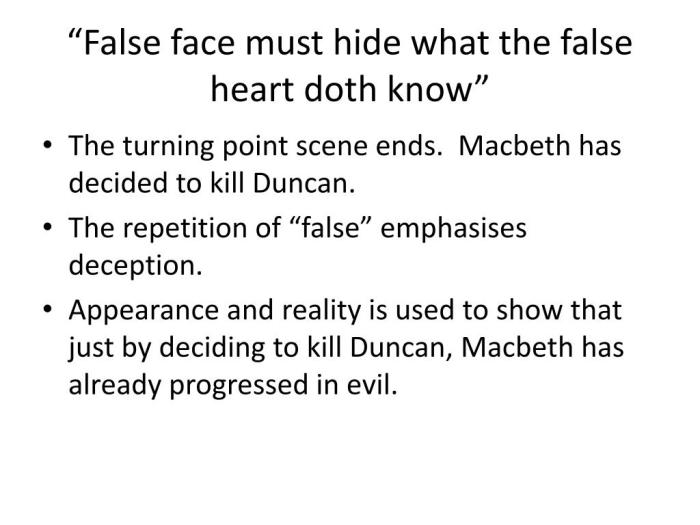False face must hide what the false heart doth is a phrase that encapsulates the idea of concealing one’s true intentions and emotions behind a facade of deception. Throughout history and literature, individuals have employed false faces to protect themselves, manipulate others, or maintain social harmony.
This exploration will delve into the significance of “false face” as a metaphor for deception, the impact of falsehood on relationships, the ethical implications of concealing one’s true self, and literary and artistic expressions of this theme.
Exploring the Concealment of False Intentions: False Face Must Hide What The False Heart Doth
The concept of “false face” has long been used as a metaphor for deception, representing the act of hiding one’s true motives and intentions behind a facade of sincerity. Throughout history and literature, numerous examples can be found where individuals have employed false faces to conceal their true selves.
One prominent example is the character of Iago in Shakespeare’s Othello. Iago’s outward demeanor is that of a loyal and trustworthy friend, but his true intentions are malicious and manipulative. He uses his false face to gain the trust of Othello and ultimately leads to his downfall.
Psychological Mechanisms Behind Concealing False Intentions
The psychological mechanisms behind concealing false intentions are complex and involve a combination of cognitive and emotional processes. One key mechanism is self-deception, where individuals may genuinely believe their own false persona and rationalize their actions accordingly.
Another mechanism is impression management, where individuals consciously manipulate their behavior and appearance to create a desired impression on others. This can involve suppressing true feelings and emotions, or exaggerating certain qualities to fit in or gain approval.
The Impact of Falsehood on Relationships

Hiding one’s true self can have a profound impact on relationships. Trust is essential for any meaningful connection, and when one party is not being genuine, it can damage the foundation of the relationship.
Maintaining a false persona can also lead to feelings of isolation and loneliness, as individuals may feel they cannot be truly known or accepted for who they are. Furthermore, it can hinder personal growth and development, as individuals may not be able to explore their true selves or learn from their mistakes.
Revealing True Intentions and Positive Outcomes, False face must hide what the false heart doth
In some cases, revealing one’s true intentions can lead to positive outcomes. Honesty and transparency can build trust and foster stronger connections. It can also allow individuals to break free from the constraints of their false persona and live more authentically.
For example, in the film The Shawshank Redemption, the character of Andy Dufresne initially hides his true identity as a banker. However, when he reveals his past to his fellow inmates, it leads to respect and admiration, and ultimately helps him to achieve his goals.
The Falsehood-Virtue Paradox

The act of concealing one’s true self raises ethical implications. On the one hand, there may be instances where maintaining a false face is necessary to protect oneself or others from harm.
On the other hand, the desire for authenticity and the need for social conformity can create a tension for individuals. They may feel torn between being true to themselves and conforming to societal expectations or avoiding negative consequences.
Potential Benefits of Falsehood
In some cases, maintaining a false face may have certain benefits. It can allow individuals to protect themselves from harm, such as in situations of danger or abuse.
Additionally, it can enable individuals to achieve certain goals, such as gaining social acceptance or career advancement, by presenting a persona that aligns with desired expectations.
Literary and Artistic Expressions of the Theme

The theme of false faces and hidden intentions has been explored extensively in literature and art throughout history.
Literary Works
In Nathaniel Hawthorne’s novel The Scarlet Letter, the character of Hester Prynne wears a scarlet letter “A” on her chest as a punishment for adultery. This letter becomes a symbol of her hidden sin and the false persona she must maintain to protect her reputation.
Artistic Representations
In art, the concept of false faces has been visually represented in various ways. For instance, the famous painting The Screamby Edvard Munch depicts a figure with a distorted face, symbolizing the anguish and inner turmoil of the individual.
FAQ Insights
What are the psychological mechanisms behind concealing false intentions?
Individuals may conceal false intentions due to fear of judgment, shame, or social rejection. They may also employ defense mechanisms such as denial, rationalization, or projection to protect their self-image.
How can hiding one’s true self damage trust and intimacy in relationships?
When individuals maintain a false persona, they create a barrier to genuine connection and intimacy. Trust is undermined as the other person feels deceived and unable to rely on the true intentions of their partner.